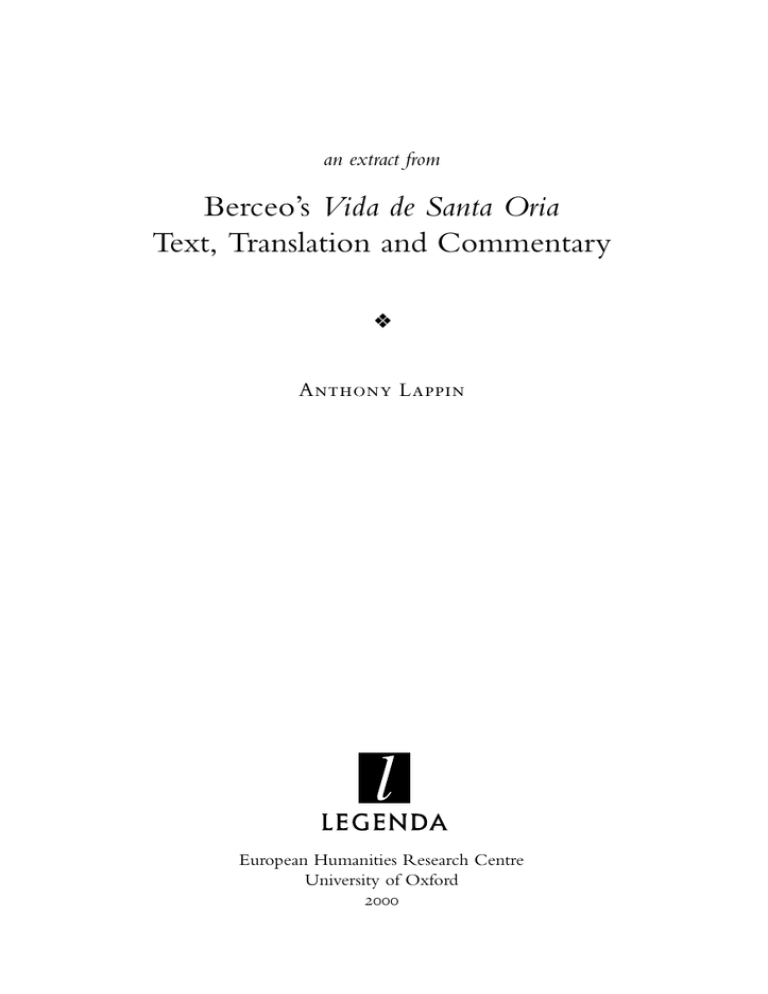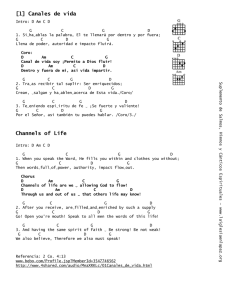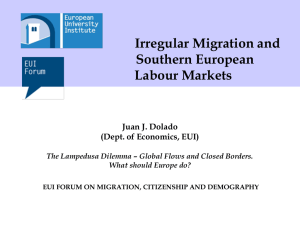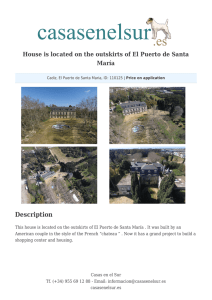Berceo`s Vida de Santa Oria Text, Translation and Commentary
Anuncio

an extract from Berceo’s Vida de Santa Oria Text, Translation and Commentary ❖ A L European Humanities Research Centre University of Oxford L: B’ V () This Internet-published extract consists of the title, imprint and contents pages together with an extract from the Introduction. The complete book is published in paperback: www.ehrc.ox.ac.uk/legenda Published by the European Humanities Research Centre of the University of Oxford Wellington Square Oxford OX JF LEGENDA is the publications imprint of the European Humanities Research Centre ISBN 1 900755 17 3 First published All rights reserved. No part of this publication may be reproduced or disseminated or transmitted in any form or by any means, electronic, mechanical, photocopying, recording or otherwise, or stored in any retrieval system, or otherwise used in any manner whatsoever without the express permission of the copyright owner British Library Cataloguing in Publication Data A CIP catalogue record for this book is available from the British Library © European Humanities Research Centre of the University of Oxford LEGENDA series designed by Cox Design Partnership, Witney, Oxon Printed in Great Britain by Information Press Eynsham Oxford OX JJ Chief Copy-Editor: Genevieve Hawkins Editorial Consultant: Michael Wood L: B’ V () CONTENTS ❖ I Foreword ix Abbreviations x Introduction Text and Translation: Vida de Santa Oria de Gonzalo de Berceo The Life of Saint Oria by Gonzalo de Berceo II Commentary to Berceo’s Vida de Santa Oria III Textual Notes Word List Bibliography Index L: B’ V () INTRODUCTION (EXTRACT) ❖ The Vida de Santa Oria is preserved in only one medieval manuscript, Real Academia Española, MS . From linguistic evidence the manuscript can be dated to the last quarter of the fourteenth century at the earliest, since, at VSO c, the scribe wrote fazés instead of the older form, feches or fazedes, an aspect which is more fully discussed at the textual note to this line. The manuscript was held at San Millán until the expulsion of religious orders was decreed by Spanish liberal governments during the nineteenth century, and only rediscovered at the beginning of the twentieth by C. Carroll Marden, who donated the codex to the Real Academia Española. The manuscript is in a folio format, and has therefore been termed F. From descriptions made during the eighteenth century, it is possible to state that F contained all works by Berceo that are known. Another manuscript containing some works by Berceo was also held by San Millán, although it is no longer extant. Since it was in a small quarto format, it has been termed Q and would seem to have been written during the thirteenth century. When copies were made of Berceo’s works during the eighteenth century by Frs Mecolaeta and Ibarreta, they generally preferred Q over F, since the former was self-evidently the earlier manuscript. For the Gonzalo de Berceo, Cuatro poemas de Berceo (Milagros de la iglesia robada y de Teófilo, y vidas de Santa Oria y de San Millán): nuevo manuscrito de la Real Academia Española, ed. C. Carroll Marden, Revista de filología española, anejo (Madrid: Hernando, ); id., Veintitrés milagros: nuevo manuscrito de la Real Academia Española, ed. C. Carroll Marden, Revista de filología española, anejo (Madrid: Hernando, ). For the fate of Berceo’s works during the ‘exclaustración’, see Isabel Uría Maqua and Fernando Manrique López, ‘Los folios LXXXIII y LXXXIV que faltan en el Ms. b de la Real Academia Española (Códice “in folio” de las obras de Berceo)’, Boletín de la Real Academia Española (), –. See, most recently, Brian Dutton, A New Berceo Manuscript: Madrid, Biblioteca Nacional Ms : Description, Study and Partial Edition, Exeter Hispanic Texts (Exeter: University of Exeter, ), pp. vii–xv. L: B’ V () Vida de Santa Oria, however, F was used for both Mecolaeta’s and Ibarreta’s transcription (termed M and I respectively). We may therefore be quite confident in asserting that, by the eighteenth century at least, Q did not contain the Vida de Santa Oria, and may never have contained it. Our only witness to the text, then, is F, even though it is a late copy; where F has become deficient since the eighteenth century, I and M have been used to remedy the lacuna. My procedure in the edition of the text has been to maintain the readings of the manuscript when these are metrically viable and to respect the order of stanzas as given in the manuscript, with one exception where seven stanzas have been transposed owing to an error in the archetype. The author of the Vida de Santa Oria was Gonzalo de Berceo, who was born in Berceo towards the end of the twelfth century, was educated during his childhood in the local monastery, San Millán, and almost certainly attended the University of Palencia during his youth. He was a secular cleric, occupying the role of deacon to the church of Berceo by . He may have held a position in the curia of Juan Pérez, bishop of Calahorra, before returning as a priest to Berceo by . He was referred to posthumously as ‘maestro de confessión’ in a document of . Berceo’s works connect him closely to those men, such as Juan Pérez, who strove for religious reform. Cf. Dutton, OC v. . For a discussion of the relative importance of the MSS Q and F, see my article, ‘The manuscript tradition of Gonzalo de Berceo’s works’, in Manuscripts and Texts: Papers from the King’s College London Colloquia, ed. David Hook, King’s College London Series (London: Department of Spanish and SpanishAmerican Studies, King’s College London, ). M is held in the library of D. Bartolomé March Severa amongst the papers of Juan de Iriate, MS //S: Isabel Uría Maqua, ‘La copia del Poema de Santa Oria que cita el P. Sarmiento en sus Memorias’, Incipit (), –; I is held in the archive of the Benedictine Abbey of Santo Domingo de Silos, MS : OC i. (), –. I am most grateful to the librarian of the Abbey of Silos, Lorenzo Maté, OSB, for his kindness in providing me with a photocopy of this text. A copy of the Mecolaeta transcription (G) served as the basis for Sánchez’s edition of the poem in , and is to be found in Madrid, Biblioteca Nacional, MS /. Documents from the archive of San Millán which mention Gonzalo de Berceo were edited by Joaquín Peña, Páginas emilianenses (Salamanca: Revista Ioseph, ), –, reprinted from Berceo (), –; some have been re-edited by Claudio and Javier García Turza, Una nueva visión de la lengua de Berceo a la luz de la documentación emilianense del siglo XIII (Logroño: Universidad de la Rioja, ), –. On the poet’s biography, see Fernando Baños (ed.), Gonzalo de Berceo, Milagros de Nuestra Señora, Biblioteca Clásica (Barcelona: Crítica, ), pp. xxix–xli; Pedro M. Cátedra, ‘Del Sacrificio de la Misa: edición y comentario’, in Gonzalo de Berceo, Obra L: B’ V () The Poem Since the Vida de Santa Oria was written during the poet’s vegez (VSO a), we may date it approximately to the late s. It is the most interesting of Berceo’s works, given its subject matter: the life and visions of an eleventh-century anchoress who was enclosed in the Mozarabic monastery of San Millán and buried nearby. It was written to be performed on the saint’s feast day, perhaps as the sermon for the mass (VSO b, d). The Vida opens with a prologue, in which the main characters are identified; the work continues with a description of Oria’s good and religious parents, Garçía and Amunna, Oria’s birth as the answer to their prayers, her mother’s vocation to be an anchoress and Oria’s subsequent vocation to the same state. After she was enclosed as an anchoress, Oria remained in her cell for a number of years before experiencing three visions. The narration of these visions forms the body of the narrative and Oria’s claim to sanctity. In the first vision, which occurs on the feast of the virgin-martyr Eugenia, two days after Christmas, three virgin-martyrs descend to Oria’s cell to invite her to ascend with them to see the glory they receive in heaven. They do this in order to reward Oria’s ascetism and her devotion to the reading of their passions. Oria at first refuses to ascend to heaven, but is encouraged to focus upon one of the doves the virgins carry. She catches sight of a huge column stretching into heaven, alongside which there is a ladder. As the virgins rise upwards, completa, ed. Isabel Uría Maqua, Clásicos Castellanos, nueva serie (Madrid: Espasa Calpe/Gobierno de la Rioja, ), –, at –; Brian Dutton, ‘La fecha del nacimiento de Gonzalo de Berceo’, Berceo – (), –, and ‘Gonzalo de Berceo: unos datos biográficos’, Actas del Primer Congreso Internacional de Hispanistas, ed. Frank Pierce and Cyril A. Jones (Oxford: Dolphin, ), –. Gregory Peter Andrachuk, ‘Berceo’s Sacrificio de la Misa and the Clérigos ignorantes’, in Hispanic Studies in Honor of Alan D. Deyermond: A North American Tribute, ed. John S. Miletich (Madison: Hispanic Seminar of Medieval Studies, ), –; Francisco Rico, ‘La clerecía del mester’, Hispanic Review (), –, –; Roger Wright, Late Latin and Early Romance in Spain and Carolingian France, Arca: Classical and Medieval Texts, Papers and Monographs (Liverpool: Francis Cairns, ), –; on the reformers in general, see Peter Linehan, The Spanish Church and the Papacy in the Thirteenth Century, Cambridge Studies in Medieval Life and Thought, rd series (Cambridge: Cambridge University Press, ). On Berceo’s links to contemporary French literature, see Miguel Ibáñez Rodríguez, Gonzalo de Berceo y las literaturas transpirenaicas: lectura cortés de su obra mariana (Logroño: Consejería de Cultura, Deportes y Juventud, ). L: B’ V () so does Oria. They come to the top of the column, and find a tall tree in the centre of a meadow. The four sit in the tree. Oria, looking up, can see windows in heaven from which three angels descend to lift the virgin-martyrs up into heaven on staffs; Oria ascends by continuing to gaze at the dove. On entering heaven, Oria is met by two processions, one of calonges (canons), the other of bishops. In each procession she recognizes people from La Rioja. She is raised to another level, where she is greeted by the procession of the virgin-martyrs and informed that she is worthy of a place among them. Emboldened by this news, Oria asks for her spiritual mother, Urraca, who encouraged her to choose the anchoritical life. Urraca is called for and replies, but, although Oria can hear Urraca’s voice, she cannot see her. However, in following Urraca’s voice, Oria comes to a palace in which there is an empty chair watched over by a young and beautiful woman called Vox Mea. From this position Oria can see the martyrs and hermits above her, and above them, the apostles and evangelists, sitting on the thrones upon which they will judge. Although she can hear Christ speaking amongst the apostles and evangelists, she cannot see him. Oria’s attention is drawn back to the chair, and she asks whose it is; Vox Mea informs her that the chair and the palace are for her. Yet she must return to the body for a while before she may take possession of them. Oria appeals to the virgin-martyrs to pray to Christ that she may be allowed to remain, and Christ speaks to her from heaven, although again he remains unseen. He confirms that she must return to the body but promises that he will bring her back to heaven again. After this, the three virgin-martyrs take Oria down the ladder to her cell, where she awakes with grief because she has had to leave heaven. She remains wedded to her asceticism and avoids the temptation of pride. Nearly a year later, towards the beginning of November, Oria receives her second vision. During the night, three virgins enter her cell bringing with them a large bed. They invite Oria to lie in the bed, an invitation Oria refuses; they then take hold of her and, hitting her, throw her upon the bed. At that moment, the cell is filled with virgins and the Blessed Virgin enters. A conversation with Oria ensues: Oria asks the Virgin to give her a sign that will show that the vision is true; the Virgin promises that Oria will soon fall sick and die as that sign. Oria is immediately depicted as suffering in her agony before death. At this point she has another vision, in which she is transported to the Mount of Olives and sees upon the plain around the mountain a great L: B’ V () number of white-clad men who greet her. The vision is snatched from her when her mother shakes her awake, and she mouths the words, ‘Monte Oliveti’ while remaining half-unconscious. A senior monk, Munno, is called, and Oria awakes at his arrival. She describes the vision to him, and they both coincide in their wish to reach heaven. Munno prevails upon Oria’s mother, Amunna, to rest for a short while. During her sleep, she dreams of Garçía, Oria’s father, who announces that Oria is to die that very day. Amunna returns to Oria, and, in a final conversation with her daughter, asks her if she has had any other visions; Oria refuses to speak further, and dies at nightfall. The monks and nuns of the monastery keep vigil around her corpse, and it is buried the following day. Berceo notes that Amunna was buried with Oria, invites his listeners to venerate their relics, and then names himself in an explicit. He would seem to have carried on at a later date, since the text continues with a second vision attributed to Amunna, in which, to assuage her mother’s grief, Oria appears to her in order to ask that clerics be summoned, so that she may take communion; the vision immediately recounts how Oria reveals that her place in heaven is with the Holy Innocents and vanishes from Amunna’s eyes. The text ends with a final explicit naming the hagiographer, Munno, as the source, and asserting the truthfulness of the tale.





![mayo a octubre [may to october] atención: el bus que realiza este](http://s2.studylib.es/store/data/005070024_1-543eada77f6f2052d3fe7a1827244407-300x300.png)
